POLYGON INSCRIBED IN A CIRCLE
Subscribe to our ▶️ YouTube channel 🔴 for the latest videos, updates, and tips.
If all of the vertices of a polygon lie on a
circle, the polygon is inscribed in the circle and the circle is circumscribed
about the polygon. The polygon is an inscribed polygon and the circle is
a circumscribed circle.
Theorems About Inscribed Polygons
Theorem 1 :
If a right triangle is inscribed in a circle, then the hypotenuse is a diameter of the circle. Conversely, if one side of an inscribed triangle is a diameter of the circle, then the triangle is a right triangle and the angle opposite the diameter is the right angle.
It is illustrated in the diagram shown below.

In the diagram shown above, ∠B is a right angle if and only if AC is a diameter of the circle.
Theorem 2 :
A quadrilateral can be inscribed in a circle if and only if its opposite angles are supplementary.
It is illustrated in the diagram shown below.
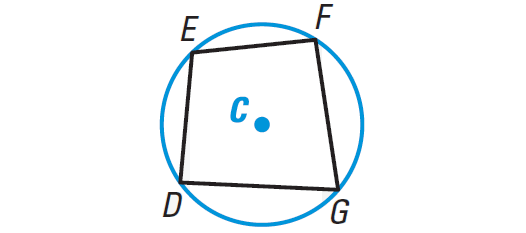
In the diagram shown above, D, E, F, and G lie on some circle with center at C, if and only if
m∠D + m∠F = 180° and m∠E + m∠G = 180°
Using Theorems 1 and 2
Example 1 :
Find the value of x in the diagram shown below.
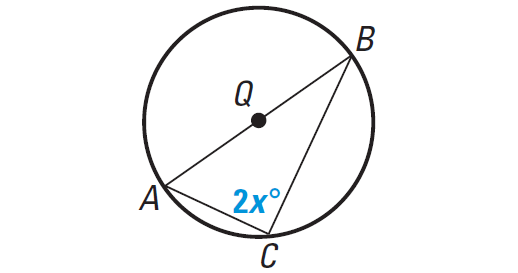
Solution :
AB is diameter. So, ∠C is a right angle and m∠C = 90°.
2x° = 90°
2x = 90
Divide each side by 2.
2x/2 = 90/2
x = 45
Example 2 :
Find the value of y and z in the diagram shown below.
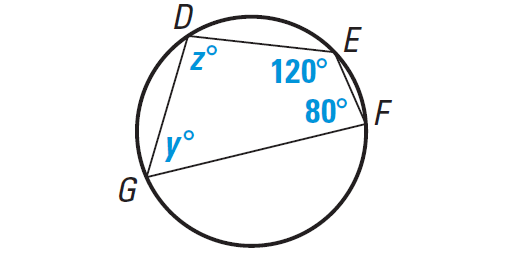
Solution :
DEFG is inscribed in a circle, so opposite angles are supplementary.
|
m∠E + m∠G = 180° 120 + y = 180 z = 60 |
m∠D + m∠F = 180° z + 80 = 180 z = 100 |
Using an Inscribed Quadrilateral
Example 3 :
In the diagram, polygon ABCD is inscribed in the circle with center P. Find the measure of each angle.
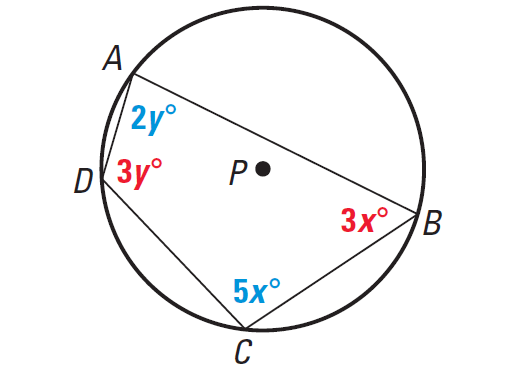
Solution :
ABCD is inscribed in a circle, so opposite angles are supplementary.
So, we have
3x + 3y = 180 -----(1)
5x + 2y = 180 -----(2)
To solve the above system of linear equations, we can solve the first equation for y.
(1)-----> 3x + 3y = 180
3(x + y) = 180
Divide each side by 3.
3(x + y) / 3 = 180 / 3
x + y = 60
Subtract x from each side.
y = 60 - x -----(3)
Plug y = 60 - x in the second equation.
(2)-----> 5x + 2(60 - x) = 180
5x + 120 - 2x = 180
Simplify.
3x + 120 = 180
Subtract 120 from each side.
3x = 60
Divide each side by 3.
3x / 3 = 60 / 3
x = 20
Plug x = 20 in the third equation.
(3)-----> y = 60 - 20
y = 40
We get x = 20 and y = 40.
So, we have
m∠A = 2y° = 2(40°) = 80°
m∠B = 3x° = 3(20°) = 60°
m∠C = 5x° = 5(20°) = 100°
m∠D = 3y° = 3(40°) = 120°
Example 4 :
In Figure, ∠ABC = 69°, ∠ACB = 31°, find ∠BDC.
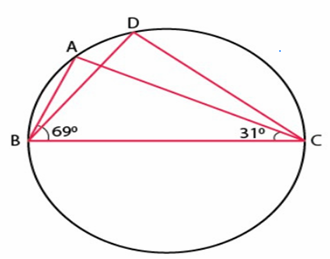
Solution :
In triangle ABC,
∠ABC = 69°, ∠BCA = 31° and ∠BAC = ?
∠ABC + ∠BCA + ∠BAC = 180
69 + 31 + ∠BAC = 180
∠BAC = 180 - (69 + 31)
= 180 - 100
= 80
Angle measures created by the same arc will be equal.
∠BAC = ∠BDC = 80
Example 5 :
In Figure, ∠PQR = 100°, where P, Q and R are points on a circle with centre O. Find ∠OPR.
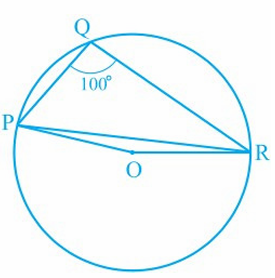
Solution :
Sum of opposite angles is 180 degree.
∠PQR + ∠PSR = 180
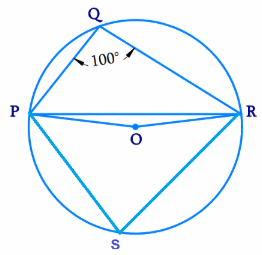
100 + ∠PSR = 180
∠PSR = 180 - 100
∠PSR = 80
∠POR = 2∠PSR
∠POR = 2(80)
= 160
∠POR + ∠OPR + ∠ORP = 180
Here ∠OPR = ∠ORP because equal sides will create equal angles.
160 + ∠OPR + ∠OPR = 180
2∠OPR = 180 - 160
2∠OPR = 20
∠OPR = 20/2
∠OPR = 10
Example 6 :
In figure, if OA = 5 cm, AB = 8 cm and OD is perpendicular to AB, What is the length of CD ?
a) 2 cm (b) 3 cm (c) 4 cm (d) 5 cm

Solution :
OA = 5 cm, AB = 8 cm
AC = AB/2 ==> 8/2
AC = 4 cm
In triangle OAC,
OA2 = OC2 + AC2
52 = OC2 + 42
25 = OC2 + 16
OC2 = 25 - 16
OC2 = 9
OC = 3 cm
OC and CD will be equal, because these two are radii.
OD = 5 cm
OC + CD = 5
3 + CD = 5
CD = 5 - 3
CD = 2 cm
Example 7 :
In figure, if ∠OAB = 40°, then what is the measure of ∠ACB?
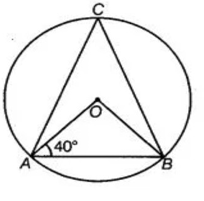
Solution :
In triangle OAB,
∠OAB + ∠OBA + ∠AOB = 180
40 + 40 + ∠OAB = 180
∠OAB = 180 - 80
∠OAB = 100
∠ACB = ∠OAB/2
∠ACB = 50
Example 8 :
Use the Inscribed Right Triangle-Diameter Theorem to set up and solve an equation to find the value of x.

Solution :
Since XZ is the diameter of the circle,
∠XYZ = 90
23x - 2 = 90
23x = 90 + 2
23x = 92
x = 92/23
x = 4
So, the value of x is 4.
Subscribe to our ▶️ YouTube channel 🔴 for the latest videos, updates, and tips.
Kindly mail your feedback to v4formath@gmail.com
We always appreciate your feedback.
©All rights reserved. onlinemath4all.com
Recent Articles
-
10 Hard SAT Math Questions (Part - 38)
Dec 08, 25 12:12 AM
10 Hard SAT Math Questions (Part - 38) -
SAT Math Practice
Dec 05, 25 04:04 AM
SAT Math Practice - Different Topics - Concept - Formulas - Example problems with step by step explanation -
10 Hard SAT Math Questions (Part - 37)
Dec 03, 25 07:02 AM
10 Hard SAT Math Questions (Part - 37)


